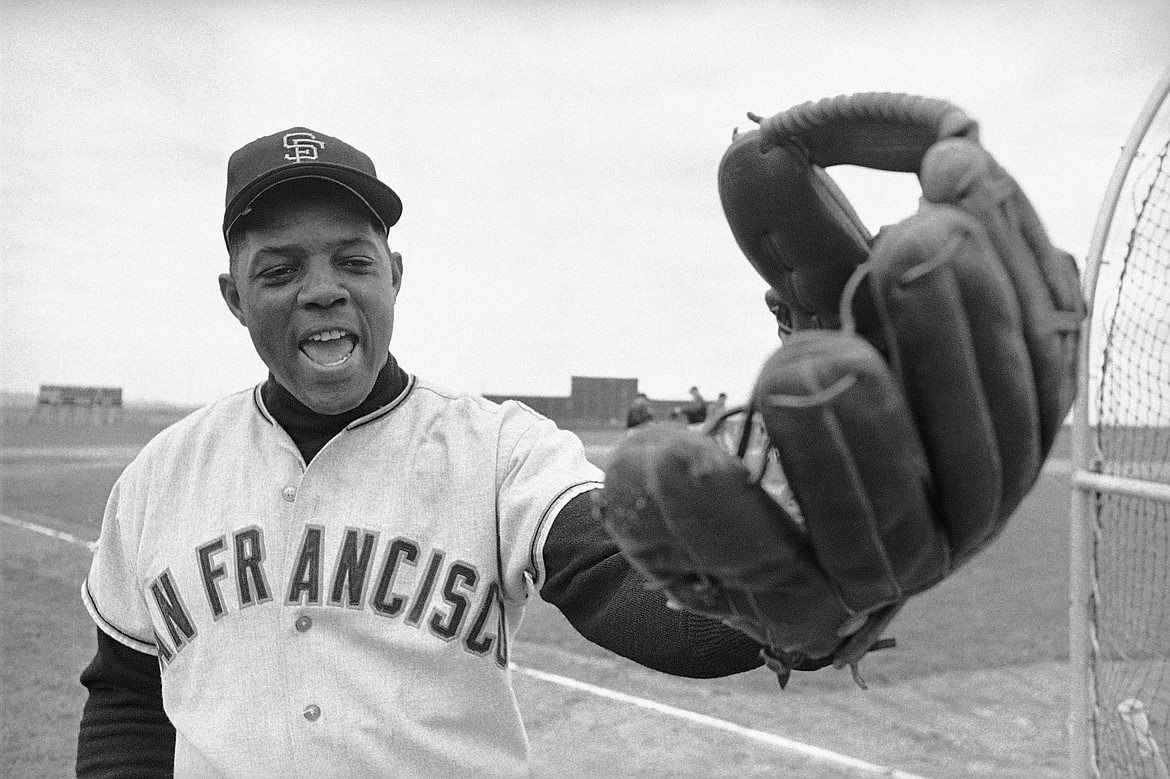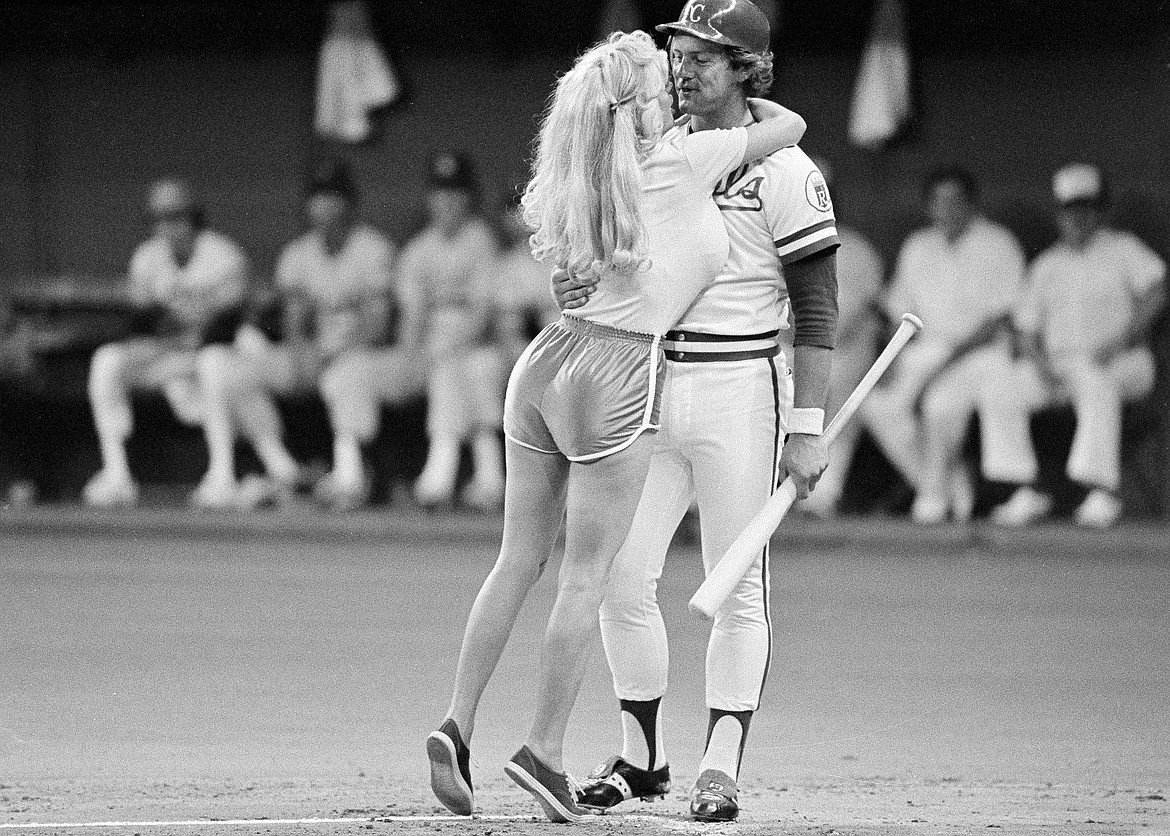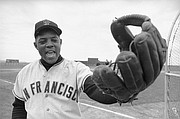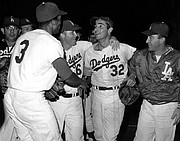MOMENTS, MEMORIES and MADNESS with STEVE CAMERON: The best baseball players I ever saw in person — by position
We’re going off-script a little bit today.
Well, now that I think about it just a few minutes more, maybe not — because what we’re doing is about personal experience.
One of the latest “lockdown discussions” is meant, I suppose, to replace the start of the baseball season.
In just the last week, three friends have called to request the same thing: “Let’s name the best players we’ve ever seen IN PERSON at each position on a baseball field.”
All three used the same format for position players, with one right-handed starting pitcher and one lefty — plus a single reliever.
The only difference I discovered was that one pal insisted on adding a designated hitter, the other two did not.
Now, if I heard about this parlor game from three people in a week, it must be getting popular among a lot of you, too.
IN ANY event, I’m going to share my “team” and explain each selection.
As background, I grew up in the Bay Area and lived there through college. I’ve visited southern California a lot, but the biggie for me was 15 years (over three different time spans) covering the Kansas City Royals up close.
I saw a lot of the Cubs and Cardinals as a sports editor in Decatur, Ill.
Oh, and as a columnist for the Denver Post, I was assigned to the World Series a few times.
And finally, I’m older than a lot of you.
No, I never saw the Babe, but …
You get what I mean.
Ready?
(By the way, everyone is invited to send me your own “teams” and I’ll print some opinions when I get them. But remember, the players have to be guys you actually saw in person. TV doesn’t count, OK?)
We’ll start by going around the diamond, then to the outfield, and finally to the pitchers.
Last rule: You can’t just move a player out of the position where he played most of his career — you know, just to fit in an extra superstar.
The team name in parenthesis with each player is the one with whom he spent most of his career, or if it’s someone who moved around, it’s the team on which I saw him.
Good.
Let’s play ball …
CATCHER — Johnny Bench (Cincinnati).
I’m not old enough — and grew up on the wrong coast — to have seen Yogi in person, so this position was a slam dunk to get started.
If you think you have someone better than Bench or Berra, I’m sorry.
Try football.
FIRST BASE — Willie McCovey (San Francisco).
My favorite Giant growing up, but also a man who hit baseballs harder than anyone I’ve ever seen — and that covers a couple thousand big-league games.
Totally by accident, I saw McCovey’s first game. Two other kids and I were allowed to take a bus about 16 miles to Seals Stadium, where our Giants had been slumping at the plate.
McCovey was summoned from AAA Phoenix, and went 4-for-4 against Phillies Hall of Famer Robin Roberts — two singles (one off the right field wall) and two triples.
Willie Mac went on to hit 521 home runs, including one I saw at Candlestick Park that was smashed with such force that it slammed into a seat in right field and rolled all the way back to the infield.
SECOND BASE — Joe Morgan (Cincinnati).
Tough to ignore this Hall of Fame, do-it-all sparkplug, but this position was a little tougher than I expected.
For instance, I saw Ryne Sandberg in his prime — which tells you everything you need to know.
Just another Hall of Famer.
Also, for what it’s worth, Kansas City’s Frank White, with his eight Gold Gloves, was far and away the best defensive second baseman I ever watched.
And as you’ll see shortly, I don’t like MLB’s trend toward home runs and an imitation of slow-pitch softball. Defense wins games, too, so …
SHORTSTOP — Ozzie Smith (St. Louis).
Fine, try to sell me on Derek Jeter or Cal Ripken, Jr. They are great players who brought offense and something close to immortality to this position.
Then there’s the fantastic Ernie Banks, who almost hit a home run into my lap during the first night game ever played at Candlestick Park.
But the Wizard of Oz stole a run or two per game for the Cardinals, and performed feats of magic at shortstop that I wouldn’t have believed possible.
And as he got a bit older and stronger, Ozzie became a decent situational hitter, too.
Ah, but that glove!
THIRD BASE — George Brett (Kansas City).
Yes, I wrote a book with him (“Last of a Breed”) and collaborated on another when he was inducted into the Hall of Fame (“From Here to Cooperstown”), but this pick has nothing to do with friendship.
George was the second-best clutch player I’ve ever seen — you’ll meet No. 1 in center field — and several times he simply willed the Royals to huge victories, including a World Series title in 1985.
For what it’s worth, I saw his first hit, his 3,000th, and then his last (3,154) — all in person.
Quick aside: Everyone remembers the “Pine Tar Game” in 1983, when George lost his mind after being called out for having excessive gooey stuff on his bat.
Lost in the madness was the home run he’d just hit, an upper-deck shot off Goose Gossage.
“I still can’t believe he did that,” Gossage said afterward. “If he hadn’t swung and made contact, that pitch might have hit him in the jaw.”
I suppose I owe a quick defense here for fans of Mike Schmidt, another Hall of Famer who had more power than Brett (548 HRs to Brett’s 317), and was arguably a better defender.
My tie-breaker: Good pitchers had a fair shot at getting Schmidt out in crucial situations — he was just a .267 hitter with tons of Ks. Brett, however, was absolutely deadly whenever it really mattered.
LEFT FIELD — Barry Bonds (San Francisco).
I know, I know. He was juiced up in the second phase of his career.
My argument — and the reason I picked Bonds over Carl Yastrzemski — is that Barry was ALREADY a Hall of Famer before he ever saw a needle.
His career in Pittsburgh alone marked him as the best combination hitter/power/fielder in left …perhaps in the history of the game.
It was after that when he bulked up and his home runs started zooming even further.
But bigger or not, Bonds still had to hit those pitches — and his prodigious walk totals tell you he wasn’t chasing the ball just to hit home runs.
Not the easiest guy to like personally (an understatement there), but a great, great player who hopefully will be voted into the Hall eventually.
Hey, every hitter who juiced in the steroid era was facing pitchers who were pharmacists, too.
CENTER FIELD — Willie Mays (San Francisco).
Simply the best baseball player who ever lived.
Is that good enough?
It’s a shame that Mays played the same position as Ken Griffey, Jr., because Junior was spectacular and productive at the same time.
Unfortunately, Griffey runs smack into an immortal in this spot.
By the way, a day will come when Mike Trout hits that same roadblock when people start talking about the best of the best.
MLB scouts rate these tools: hit, hit for power, run and field.
Willie Mays did them all as well or better than anyone you care to name.
You can look up all his stats and they’re spectacular (plus, he’d have had more than 660 homers if he hadn’t been hitting into a 30 mile-per-hour wind every night at Candlestick Park), but even the numbers don’t tell you the whole story about the “Say Hey Kid.”
He was the best (and most imaginative) baserunner the sport has ever seen, often slowing down just enough to draw a useless throw so another runner could advance.
In the outfield?
Legendary sports columnist Jim Murray of the Los Angeles Times once wrote: “Willie Mays’ glove is where triples go to die.”
When the Giants won the National League pennant in 1962, Mays homered in his first at-bat of the season — and then also in his last, a shot that produced a playoff with the Dodgers that San Francisco won.
I once nearly got into a fistfight with a guy who made a ridiculous claim.
This lad referred to the ninth inning of Game 7 in the ’62 World Series, which ended with the Yankees winning 1-0.
The final out was a screaming line drive from McCovey that was caught by second baseman Bobby Richardson with runners Matty Alou on third base and Mays on second.
“Even if that ball had gone past Richardson, it only would have tied the game,” this guy said, “because Roger Maris was a great right fielder and the ball was hit so hard that Mays couldn’t have scored from second.”
Pardon me?
Winning run of the World Series, and Willie Mays is not going to score from second?
WILLIE MAYS???
Hahahahahaha!!
RIGHT FIELD (Tie) — Hank Aaron (Milwaukee and Atlanta), Roberto Clemente (Pittsburgh).
I started this list of great players I’ve seen one night, but couldn’t finish it until the next morning — solely because I couldn’t pick a right fielder.
Can you?
Yeah, Aaron had the home run record and he was a fantastic all-around player, but Clemente was …
He was Roberto Clemente, the man who had exactly 3,000 hits when he died in a plane crash on a humanitarian mission, and who possessed arguably the greatest throwing arm in baseball history.
To slight either of these players would be totally unfair.
The temptation, if you dislike Barry Bonds enough, is to cheat and stick Hank or Roberto in left — but we agreed to play fair with the positions.
I can’t separate these two Hall of Fame superstars.
Sorry, I just can’t.
And by the way, Aaron and Clemente have earned such legendary status that I couldn’t find a way to consider yet another Hall of Famer, Andre Dawson (438 homers, eight Gold Gloves).
Right field was loaded.
If you want to make an argument that one is definitely better than the other, my email address will be available.
Give it a shot.
LEFT-HANDED STARTER — Sandy Koufax (Los Angeles).
It’s a shame that wildness at the beginning of his career and injuries at the end meant that Sandy was Sandy for only about 5-6 years.
But in that stretch, he was the best ever.
Basically unhittable.
From 1962 through 1966, Koufax won a staggering 111 games, and his ERAs for those seasons were 2.54 (ugh), 1.88, 1.74, 2.04 and 1.73.
He struck out more than 300 batters three times in that span.
Koufax threw a fastball clocked at more than 100 miles per hour (that had a sailing motion to it just for kicks), and complemented that with a hard, hard overhand curve that started at the bill of a hitter’s cap and then dropped straight down to the dirt.
Kouifax didn’t just get hitters out, he made very good big-leaguers look foolish.
During his prime, Sandy was the closest thing to a lock winner as baseball has ever seen.
It’s just a shame that he wasn’t healthy enough to dominate for a decade or more.
Still, this exercise is about the best I ever saw in person.
That would be Sandy Koufax, which is an admitted slight to Warren Spahn and his 363 victories.
Still, if you look in several baseball reference guides, Koufax’s nickname is listed as…
“The Left Hand of God.”
Case closed.
RIGHT-HANDED STARTER — Satchel Paige (Kansas City A’s).
Yep, I’m cheating.
I only saw Satch pitch three shutout innings for the A’s in 1965, a Charles Finley stunt when Paige was 58 years old.
Still, he only gave up one hit to the Red Sox, a double by Carl Yastrzemski.
But there are two more pressing issues here …
First, it’s almost a universal truth that when Satch pitched in the Negro Leagues and during off-season barnstorming tours before joining Cleveland in 1948 (age 42, maybe), he was the best pitcher who ever fired a baseball.
That would be good enough by itself, but there’s a second reason to reach back for the wondrous Satchel Paige.
I simply can’t separate all the great right-handers I’ve seen in person.
Check this list and tell me how you pull these guys apart: Bob Gibson, Greg Maddux, Nolan Ryan, Juan Marichal and Roger Clemens.
Every one of them seemingly pitched forever (Maddux has 355 wins, eighth-best in baseball history), and their ERAs are all close enough that you could toss a blanket over them.
Gibson was so good in 1968 (1.12 ERA, 13 shutouts) that Major League Baseball lowered the mound after that season.
Gibby also pitched 20 or more complete games in a season seven times.
Ryan threw seven no-hitters and struck out more batters than anyone in history, but he also holds the career record for walks — and lost nearly as many games as he won.
And so on.
If we ignore Satchel Paige, which every old-timer insists is just plain crazy, I think I’d go with Gibson if I had to win one big game.
How’s that for a wishy-washy decision?
RELIEVER — Mariano Rivera (New York Yankees).
Well, as hard as it was to pick a right-handed starter, selecting our closer is a breeze.
Unlike all the power pitchers we’ve been discussing, Rivera didn’t throw all that hard — and his arsenal consisted of just one pitch.
Mo threw his cutter roughly 95 percent of the time.
Hitters knew it was coming, they knew what the pitch would do, and STILL they couldn’t hit it.
Left-handed hitters were more likely to break a bat (or two) than they were to make solid contact.
Right-handers generally popped out meekly or tried to pull the cutter and wound up hitting soft grounders to short.
All you need to know about the “Sandman’s” status in the game is that he was the only player allowed to keep wearing Jackie Robinson’s famous No. 42 until he retired in 2013.
Rivera saved 652 games and finished 952, both major league records, along with winning five World Series rings.
He was the first player ever voted into the Hall of Fame unanimously.
Who am I to disagree with THAT?
“Enter Sandman”…
For 17 years, when Yankee fans heard that Metallica song, it generally meant a game was in the bag.
As a bonus, Mo was and is one of the nicest people to ever play the game.
The only reliever I’d add into the “near lock” category (over a much shorter span) might be Dennis Eckersley.
What a perfect way to wrap up my personal team.
And by the way, the top backups at every position are in the Hall of Fame.
So there.
Email: scameron@cdapress.com
Steve Cameron writes the Cheap Seats column on Wednesdays and Fridays, along with “Moments, Memories and Madness” each Sunday. He also contributes the “Zags Tracker” about Gonzaga basketball once per month during the off season.
In addition, Steve authors an “isolation blog” about life at home during this coronavirus pandemic. It now appears in The Press news section on Tuesdays and Thursdays.







